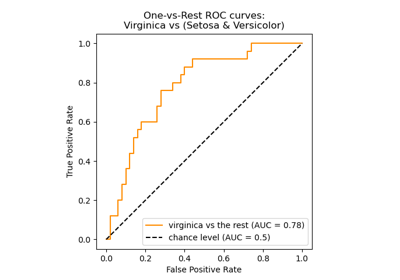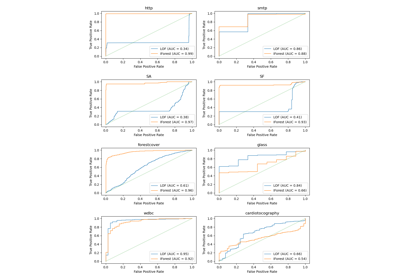sklearn.preprocessing.LabelBinarizer¶
- class sklearn.preprocessing.LabelBinarizer(*, neg_label=0, pos_label=1, sparse_output=False)[source]¶
Binarize labels in a one-vs-all fashion.
Several regression and binary classification algorithms are available in scikit-learn. A simple way to extend these algorithms to the multi-class classification case is to use the so-called one-vs-all scheme.
At learning time, this simply consists in learning one regressor or binary classifier per class. In doing so, one needs to convert multi-class labels to binary labels (belong or does not belong to the class). LabelBinarizer makes this process easy with the transform method.
At prediction time, one assigns the class for which the corresponding model gave the greatest confidence. LabelBinarizer makes this easy with the inverse_transform method.
Read more in the User Guide.
- Parameters:
- neg_labelint, default=0
Value with which negative labels must be encoded.
- pos_labelint, default=1
Value with which positive labels must be encoded.
- sparse_outputbool, default=False
True if the returned array from transform is desired to be in sparse CSR format.
- Attributes:
- classes_ndarray of shape (n_classes,)
Holds the label for each class.
- y_type_str
Represents the type of the target data as evaluated by utils.multiclass.type_of_target. Possible type are ‘continuous’, ‘continuous-multioutput’, ‘binary’, ‘multiclass’, ‘multiclass-multioutput’, ‘multilabel-indicator’, and ‘unknown’.
- sparse_input_bool
True if the input data to transform is given as a sparse matrix, False otherwise.
See also
label_binarizeFunction to perform the transform operation of LabelBinarizer with fixed classes.
OneHotEncoderEncode categorical features using a one-hot aka one-of-K scheme.
Examples
>>> from sklearn import preprocessing >>> lb = preprocessing.LabelBinarizer() >>> lb.fit([1, 2, 6, 4, 2]) LabelBinarizer() >>> lb.classes_ array([1, 2, 4, 6]) >>> lb.transform([1, 6]) array([[1, 0, 0, 0], [0, 0, 0, 1]])
Binary targets transform to a column vector
>>> lb = preprocessing.LabelBinarizer() >>> lb.fit_transform(['yes', 'no', 'no', 'yes']) array([[1], [0], [0], [1]])
Passing a 2D matrix for multilabel classification
>>> import numpy as np >>> lb.fit(np.array([[0, 1, 1], [1, 0, 0]])) LabelBinarizer() >>> lb.classes_ array([0, 1, 2]) >>> lb.transform([0, 1, 2, 1]) array([[1, 0, 0], [0, 1, 0], [0, 0, 1], [0, 1, 0]])
Methods
fit(y)Fit label binarizer.
Fit label binarizer/transform multi-class labels to binary labels.
get_params([deep])Get parameters for this estimator.
inverse_transform(Y[, threshold])Transform binary labels back to multi-class labels.
set_output(*[, transform])Set output container.
set_params(**params)Set the parameters of this estimator.
transform(y)Transform multi-class labels to binary labels.
- fit(y)[source]¶
Fit label binarizer.
- Parameters:
- yndarray of shape (n_samples,) or (n_samples, n_classes)
Target values. The 2-d matrix should only contain 0 and 1, represents multilabel classification.
- Returns:
- selfobject
Returns the instance itself.
- fit_transform(y)[source]¶
Fit label binarizer/transform multi-class labels to binary labels.
The output of transform is sometimes referred to as the 1-of-K coding scheme.
- Parameters:
- y{ndarray, sparse matrix} of shape (n_samples,) or (n_samples, n_classes)
Target values. The 2-d matrix should only contain 0 and 1, represents multilabel classification. Sparse matrix can be CSR, CSC, COO, DOK, or LIL.
- Returns:
- Y{ndarray, sparse matrix} of shape (n_samples, n_classes)
Shape will be (n_samples, 1) for binary problems. Sparse matrix will be of CSR format.
- get_params(deep=True)[source]¶
Get parameters for this estimator.
- Parameters:
- deepbool, default=True
If True, will return the parameters for this estimator and contained subobjects that are estimators.
- Returns:
- paramsdict
Parameter names mapped to their values.
- inverse_transform(Y, threshold=None)[source]¶
Transform binary labels back to multi-class labels.
- Parameters:
- Y{ndarray, sparse matrix} of shape (n_samples, n_classes)
Target values. All sparse matrices are converted to CSR before inverse transformation.
- thresholdfloat, default=None
Threshold used in the binary and multi-label cases.
Use 0 when
Ycontains the output of decision_function (classifier). Use 0.5 whenYcontains the output of predict_proba.If None, the threshold is assumed to be half way between neg_label and pos_label.
- Returns:
- y{ndarray, sparse matrix} of shape (n_samples,)
Target values. Sparse matrix will be of CSR format.
Notes
In the case when the binary labels are fractional (probabilistic), inverse_transform chooses the class with the greatest value. Typically, this allows to use the output of a linear model’s decision_function method directly as the input of inverse_transform.
- set_output(*, transform=None)[source]¶
Set output container.
See Introducing the set_output API for an example on how to use the API.
- Parameters:
- transform{“default”, “pandas”}, default=None
Configure output of
transformandfit_transform."default": Default output format of a transformer"pandas": DataFrame outputNone: Transform configuration is unchanged
- Returns:
- selfestimator instance
Estimator instance.
- set_params(**params)[source]¶
Set the parameters of this estimator.
The method works on simple estimators as well as on nested objects (such as
Pipeline). The latter have parameters of the form<component>__<parameter>so that it’s possible to update each component of a nested object.- Parameters:
- **paramsdict
Estimator parameters.
- Returns:
- selfestimator instance
Estimator instance.
- transform(y)[source]¶
Transform multi-class labels to binary labels.
The output of transform is sometimes referred to by some authors as the 1-of-K coding scheme.
- Parameters:
- y{array, sparse matrix} of shape (n_samples,) or (n_samples, n_classes)
Target values. The 2-d matrix should only contain 0 and 1, represents multilabel classification. Sparse matrix can be CSR, CSC, COO, DOK, or LIL.
- Returns:
- Y{ndarray, sparse matrix} of shape (n_samples, n_classes)
Shape will be (n_samples, 1) for binary problems. Sparse matrix will be of CSR format.
Examples using sklearn.preprocessing.LabelBinarizer¶

Multiclass Receiver Operating Characteristic (ROC)
